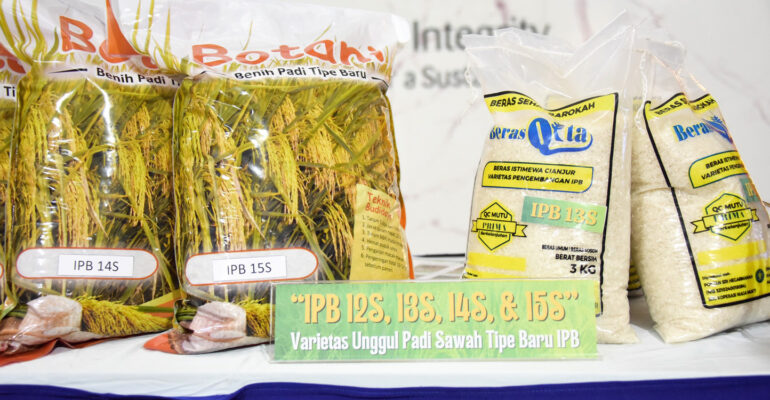IPB University Researchers Release New Superior Rice Paddy Varieties IPB 12S, IPB 13S, IPB 14S, and IPB 15S

IPB University researchers and lecturers from the Department of Agronomy and Horticulture, Faculty of Agriculture, Prof Hajrial Aswidinnoor and Dr Willy Bayuardi Suwarno have released four new varieties of IPB paddy rice.
Some rice varieties previously released, such as IPB 1R, IPB 3S, and IPB 9G have been widely utilized by the community. The varieties released this time are the 15th IPB rice varieties, and are the 10th, 11th, 12th, and 13th variety innovations from Prof Hajrial and team.
The four varieties introduced this time by IPB University to the community are the paddy rice varieties IPB 12S, IPB 13S, IPB 14S, and IPB 15S. These varieties have previously been released by the Minister of Agriculture in November 2023.
“Like the previous rice variety innovations, the varieties introduced this time are also varieties of New Type Rice (PTB) which has the character of denser panicles than generally the panicles of existing national rice varieties,” said Prof Hajrial as the head of the research team during the Launching of IPB Innovation 2025 at Dramaga Campus (5/14)
He elaborated, from testing data at 11 locations in various districts in Indonesia during the variety release preparation process, the four varieties have superior productivity and early maturing.
Potential and Average Production
1. IPB 12S variety has a yield potential of 11,78 tons/ha and an average production of 8,01 tons/ha;
2. IPB 13S variety reaches 11,55 tons/ha & 7,97 tons/ha;
3. IPB 14S variety reached 11,66 tons/ha & 8,45 tons/ha; and
4. IPB 15S variety has a potential of 10,16 tons/ha and an average production of 8,14 tons/ha.
Resistant to Major Pests and Blast Disease
Prof Hajrial revealed that these four varieties have good resistance to brown stem leafhoppers (WBC) biotypes 1, 2, and 3. Varieties IPB 12S and IPB 13S react somewhat resistant to all three biotypes of WBC pests. Meanwhile, IPB 14S and IPB 15S were moderately resistant to biotypes 1 and 2.
From testing against four blast races (races 033, 133, 073, and 173) in the greenhouse, the four varieties also showed very superior resistance reactions compared to national paddy rice varieties that are widely planted by farmers today.
Test data shows that these four IPB rice varieties have resistant and moderately resistant reactions to all (four) blast races. While the two national paddy rice varieties that were also tested together as a comparison, both reacted susceptibly to the four blast races.
“This level of resistance is a very superior character when compared to national rice varieties that are widely cultivated by farmers today,” said Prof Hajrial.
He said that good resistance to blast disease is expected to help farmers who experience blast disease attacks in their rice fields. Especially at this time, it has begun to be found in irrigated rice fields in some national rice production centers.
Special Advantages
In addition to the above superior traits, Prof Hajrial continued, each variety also has other specific superior characters. For example, IPB 12S and IPB 13S varieties have high head rice yields reaching 96 percent and 95 percent.
“Both varieties have a fluffy rice taste with amylose levels of 11 percent and 12 percent respectively. These special advantages make the IPB 12S and IPB 13S varieties potential and very suitable for the production target and premium rice market,” he said.
As for the IPB 15S variety, the initial test results showed the potential for high Fe and Zn content. Fe and Zn nutrients are minerals that are very helpful in overcoming the problems of anemia and stunting.
“The IPB 15S variety also shows relatively good production capability in moderate and poor land fertility conditions,” he continued.
He said, the combination of the potential advantages of mineral nutrient content and adaptability both on medium and low fertility land, made this variety will help if used by farmers who do not have good capital in farming – which generally the harvest will be consumed by their own households.
“The innovation of IPB 12S, IPB 13S, IPB 14S, and IPB 15S varieties is expected to add to the alternative rice varieties that can be planted by farmers, and is a contribution of IPB University in the midst of the current efforts of the Indonesian nation in striving for self-sufficiency and sustainable national food sovereignty,” concluded Prof Hajrial.
PT Botani Seed Indonesia, which has been producing and disseminating seeds of IPB University rice varieties, is the partner that will produce and disseminate these varieties to the community. (*/Rz) (IAAS/PRP)


